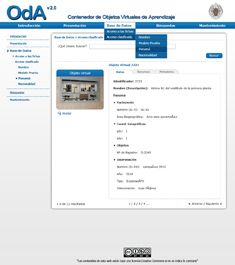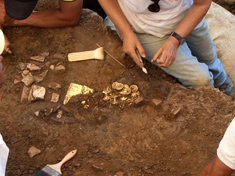
Campus Moncloa
Campus of International Excellence
New scientific software to discover academic heritage
The software OdA 2.0 is a new application which has been developed by a group of researchers at Universidad Complutense de Madrid belonging to the Heritage Cluster of the Moncloa Campus along with the collaboration of the Varadero Software Factory; a spin-off of the UCM. This application allows experts to create dynamic museums and collections of digital objects on the Internet as part of their academic activity with minimal computer knowledge and minimum technologic resources
30/05/2012
 The software OdA 2.0 is a new application which has been developed by a group of researchers at Universidad Complutense de Madrid and belonging to the Heritage Cluster of the Moncloa Campus along with the collaboration of the Varadero Software Factory; a spin-off of the UCM. This application allows experts to create dynamic museums and collections of digital objects on the Internet as part of their academic activity with minimal computer knowledge and minimum technologic resources. Five museums, UCM collections and numerous projects are proof of its success.
The software OdA 2.0 is a new application which has been developed by a group of researchers at Universidad Complutense de Madrid and belonging to the Heritage Cluster of the Moncloa Campus along with the collaboration of the Varadero Software Factory; a spin-off of the UCM. This application allows experts to create dynamic museums and collections of digital objects on the Internet as part of their academic activity with minimal computer knowledge and minimum technologic resources. Five museums, UCM collections and numerous projects are proof of its success.
Due to the importance of educational and research activities, the University has produced a large amount of material that can become Digital Objects: archaeological material, literature, art, machines, computers, scientific instruments and many more. If this material is not digitized, documented and classified it can be lost to the world by being hidden, difficult to reach, physically delicate or it may not have enough staff available for its maintenance and exhibition. It is an unexploited material for teaching, research and the dissemination of knowledge.
There is currently a lack of procedure, methods and tools for researchers, professors and students to digitize, format and encode Digital Objects of this material in a collaborative way as part of their daily common tasks, without the need to be skilled IT developers, or spending large amounts of time on it which would subtract from them accomplishing their own tasks.
The OdA Project is focused on the research and improvement of information technology and on developing and testing a prototype of application that would allow professors and students to participate in the process of converting the material into Digital Objects. The project started in early 2006 and in June 2009 they obtained the first version of de OdA that was used to create five UCM museums in different areas: the Archaeological Museum of the School of Geography and History, CHASQUI; Virtual Museum of audiovisual materials for the study of languages at the Faculty of Philology; The Museum of the School of Computing ”œGarcía Santesmases” MIGS; the museum of scientific instruments of the Faculty of Physical Sciences and finally, the collection of Philological materials, OdAFilol.

Picture: Alfredo Fernández-Valmayor
Source: Panamanian foundation ”œEl Caño”
License cc-by-na-nd
This application will allow us to create a local virtual museum on our personal computer or on the Internet if we install the application on a server. The museum can have objects and data accessible to the public but it can also be made private. Every digital object of the museum is created from a template, defined by the users who collect the data on the object. For example, if it is an archeological piece they will collect: size, color, resources (a photography of the piece), a map of the site where the piece was extracted, a scientific article and finally the metadata of the object such as the date and the author of the digital object.
Everyone can participate in the building of museums. The museums created by using OdA are living museums which are constantly evolving and growing. Researchers can study, document, classify and incorporate new objects that can be used by professors and students. For example, you can find digital objects that are works, practices or exhibitions done by students and PhD students in the ”œeducational material” section of the Archeological Museum CHASQUI.
They are currently working on numerous projects and collaborations, such as AENOR to define a quality model for Digital learning objects and the international collaboration of the Panamanian foundation ”œEl Caño” to research the creation of a multilingual virtual archaeological museum.
OdA 2.0 is flexible, simple and has a collaborative environment This application is a tool for dissemination of our scientific, technical and artistic heritage and can also be educational. To summarize, it helps to discover valuable hidden and unknown heritage that is available in the university.
Author of the article: Ana Fernández Pampillón
Tag: Patrimonio Cultural Source: CEI Campus Moncloa
Event date:
30/05/2012
